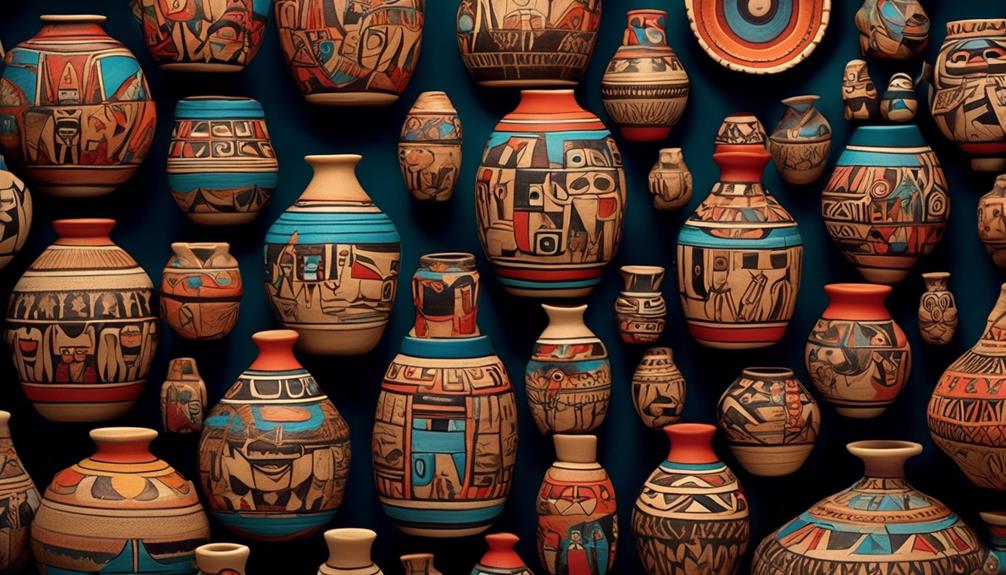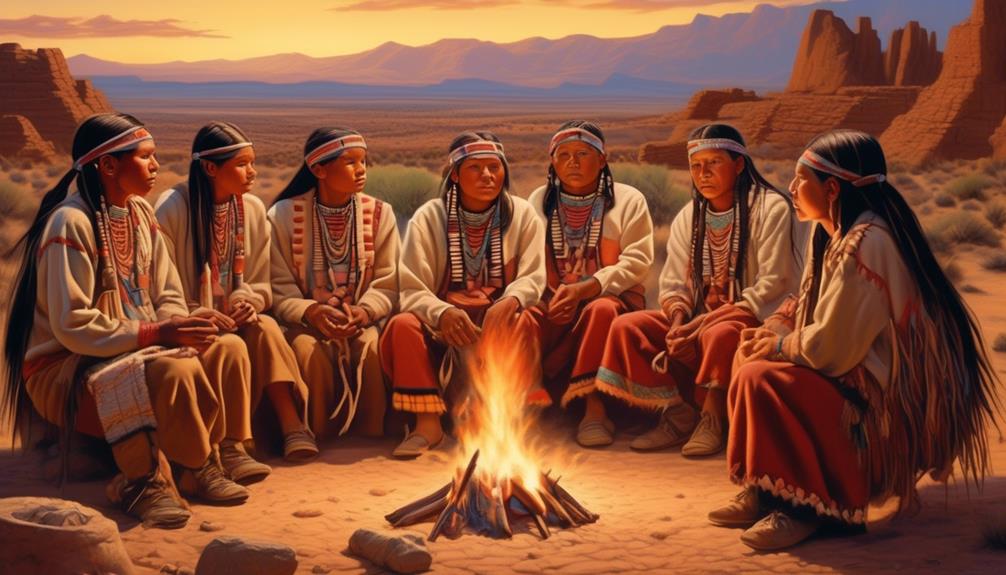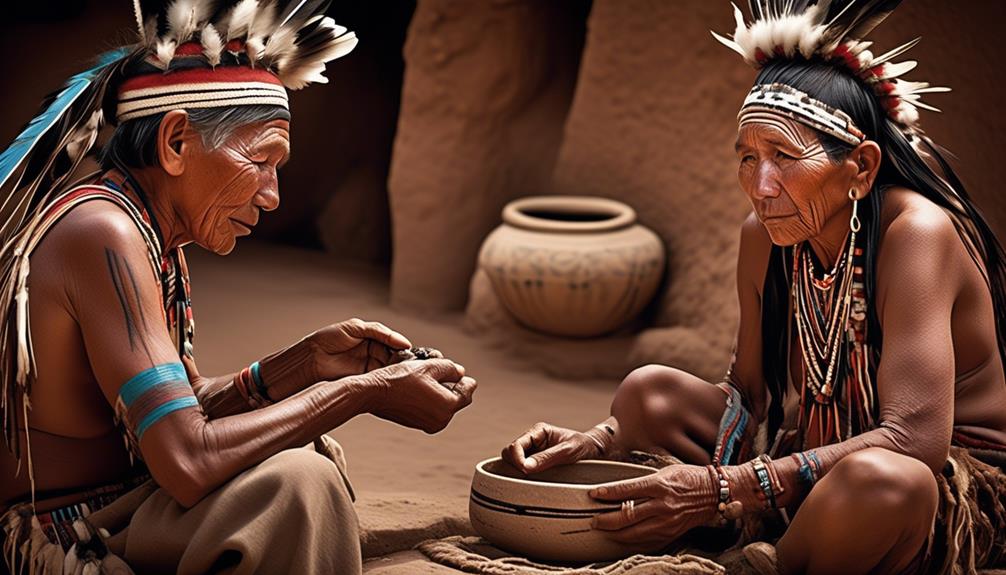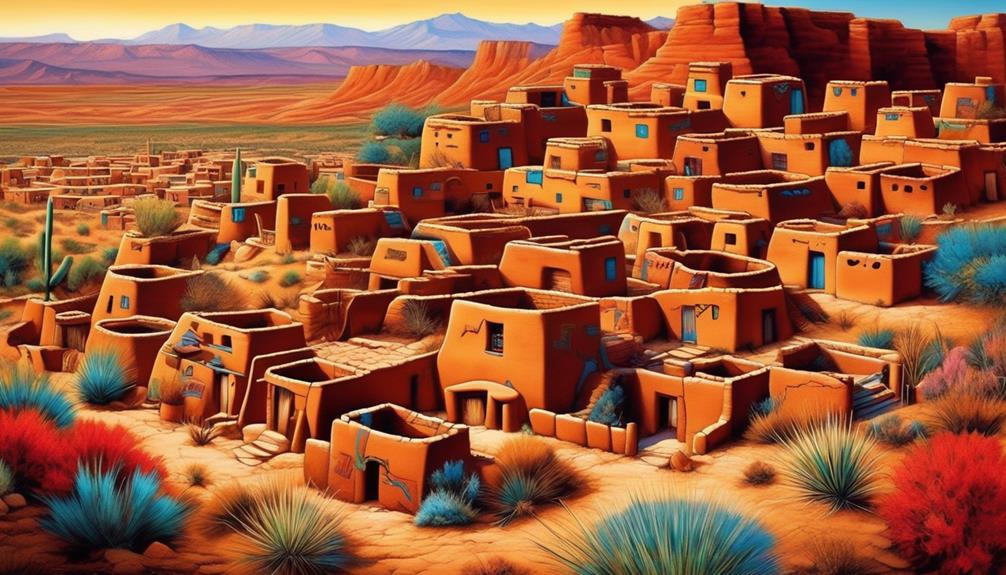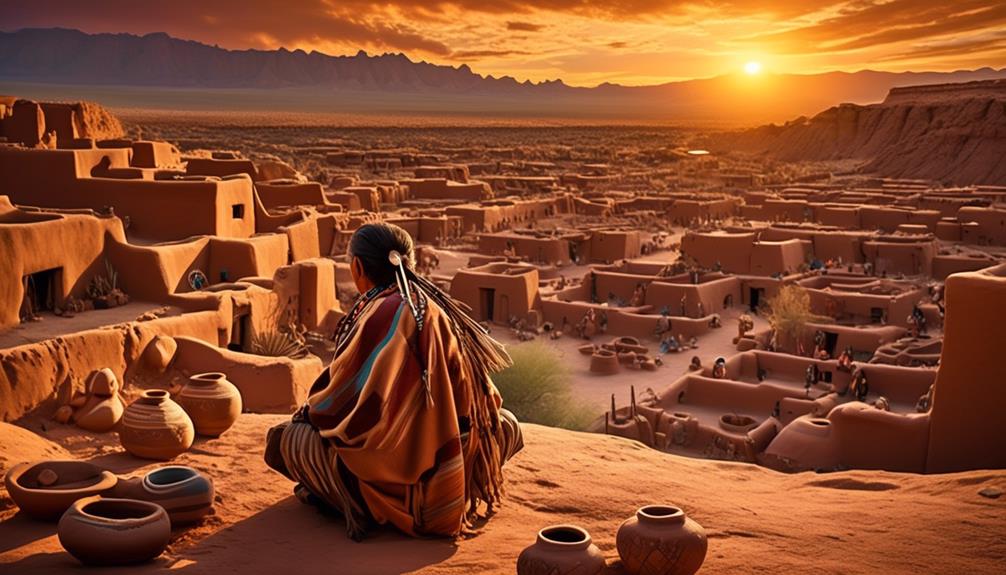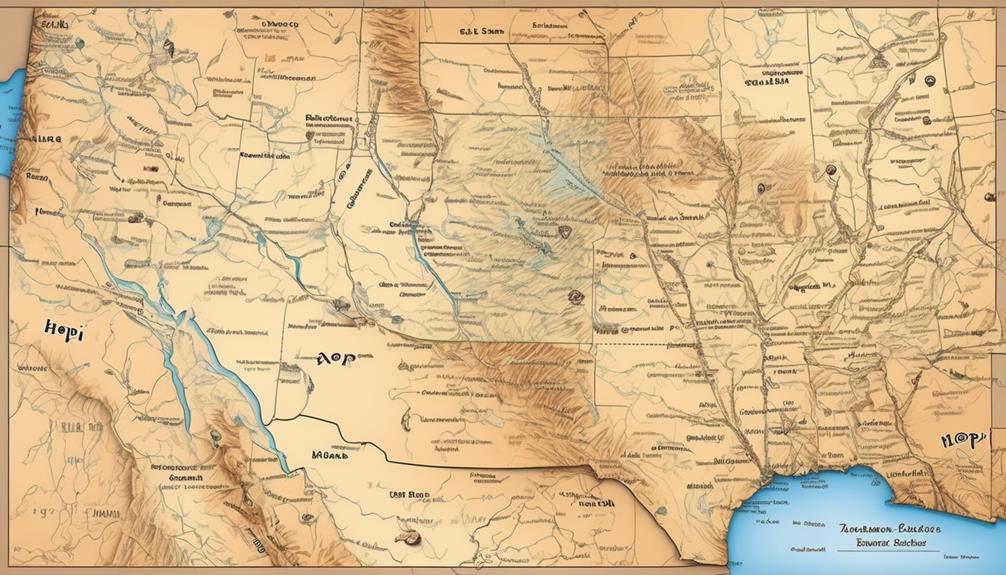When talking about the artistic and cultural impact of the Hopi tribe, the spotlight is frequently on their famous kachina dolls.
However, the depth and diversity of their craftsmanship goes far beyond these celebrated creations.
From intricately designed pottery and vibrant textiles to finely woven basketry and exquisite jewelry, the Hopi people have a rich tradition of creating a wide array of stunning and functional items.
But what makes these creations truly remarkable is the deep spiritual and symbolic significance woven into each piece, offering a fascinating glimpse into the history and beliefs of this enduring and creative culture.
Key Takeaways
- Hopi pottery and kachina dolls are known for their traditional techniques, intricate designs, and deep cultural and spiritual meanings.
- Textiles, such as weaving, play a vital role in ceremonies, rituals, and everyday life, with intricate patterns and symbolic meanings reflecting the tribe's history and storytelling.
- Jewelry, including silver earrings and turquoise necklaces, showcases beadwork techniques passed down through generations and traditional designs that reflect the tribe's spiritual connection to the natural world.
- Basketry is a skill with deep cultural significance, featuring intricate patterns and symbols that reflect cultural heritage, and is passed down through generations, with modern applications showcasing innovative designs.
Pottery
The Hopi tribe excels in crafting pottery, utilizing traditional techniques and intricate designs to create stunning and meaningful pieces of art. Their pottery is renowned for its exceptional craftsmanship, distinctive designs, and cultural significance. The firing techniques employed by the Hopi tribe are integral to their pottery-making process. Traditionally, they use outdoor firing methods, such as the use of sheep dung as fuel, which results in the unique coloration and finish of their pottery. The designs found on Hopi pottery often depict symbols and motifs that hold deep cultural and spiritual meanings, making each piece a reflection of the tribe's heritage and beliefs.
When considering traditional uses and modern adaptations, it's evident that Hopi pottery has evolved to meet contemporary demands while preserving its cultural essence. While traditional pottery served utilitarian purposes, modern adaptations have expanded to include decorative and artistic expressions. Additionally, contemporary potters have integrated new materials and firing techniques, such as electric or gas kilns, to supplement traditional methods, demonstrating the adaptability of Hopi pottery in the modern era.
The juxtaposition of traditional practices with modern innovations showcases the resilience and timelessness of Hopi pottery.
Kachina Dolls
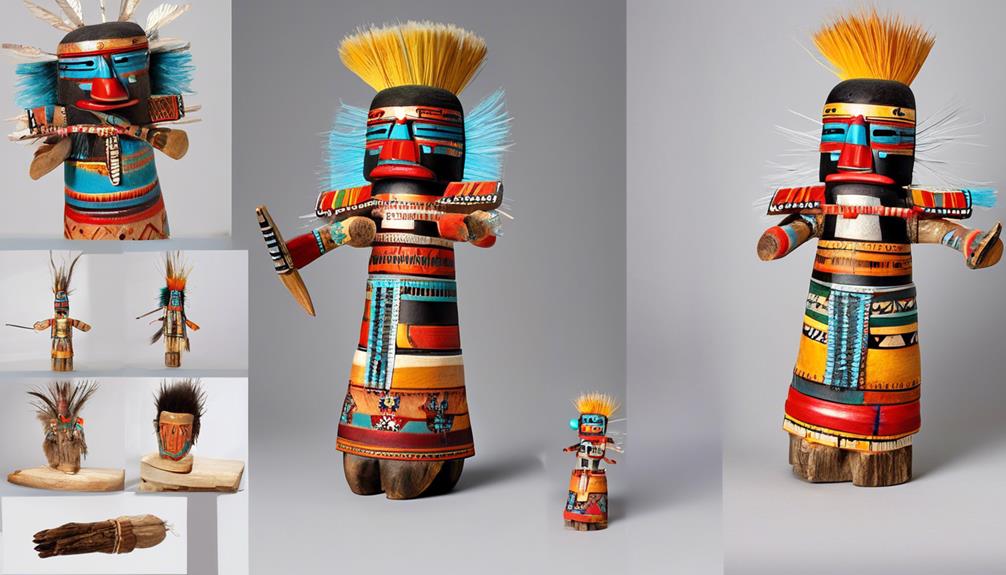
Crafting intricate and culturally significant pottery has been a longstanding tradition for the Hopi tribe, and their artistic expertise extends to the creation of Kachina Dolls. These unique and sacred dolls play a vital role in Hopi religious ceremonies and are meticulously crafted to embody spiritual significance and cultural symbolism.
Kachina Doll Symbolism: Each Kachina doll is imbued with deep symbolism, representing various deities, spirits, or ancestors important to the Hopi people. These symbols are intricately woven into the design of the dolls, reflecting the tribe's spiritual beliefs and values.
Kachina Doll Carving Techniques: The creation of Kachina dolls involves intricate carving techniques, often passed down through generations. Hopi artisans use traditional tools to carve the dolls from cottonwood roots, paying meticulous attention to detail to ensure the accurate representation of the intended symbolism.
These dolls aren't mere playthings but are revered as tangible manifestations of spiritual entities. The craftsmanship and symbolism behind each Kachina doll serve as a testament to the rich cultural heritage and artistic prowess of the Hopi tribe.
Textiles
With intricate patterns and vibrant colors, textiles have long been an integral part of the artistic heritage of the Hopi tribe. The Hopi people are renowned for their exquisite weaving techniques, which are deeply rooted in their cultural traditions. The textiles created by the Hopi tribe aren't only visually stunning but also hold immense cultural significance.
Weaving is a skill that has been passed down through generations among the Hopi people. The intricate patterns woven into their textiles often carry symbolic meanings, representing elements of the natural world, spiritual beliefs, and historical narratives. Each textile is a labor of love, reflecting the weaver's dedication to preserving their rich cultural heritage.
The cultural significance of textiles within the Hopi tribe extends beyond their artistic value. These textiles play a vital role in ceremonies, rituals, and everyday life, serving as a means of storytelling and connection to the tribe's history. The vibrant colors and patterns woven into the textiles are a testament to the Hopi people's deep spiritual connection to the earth and the natural world.
Jewelry
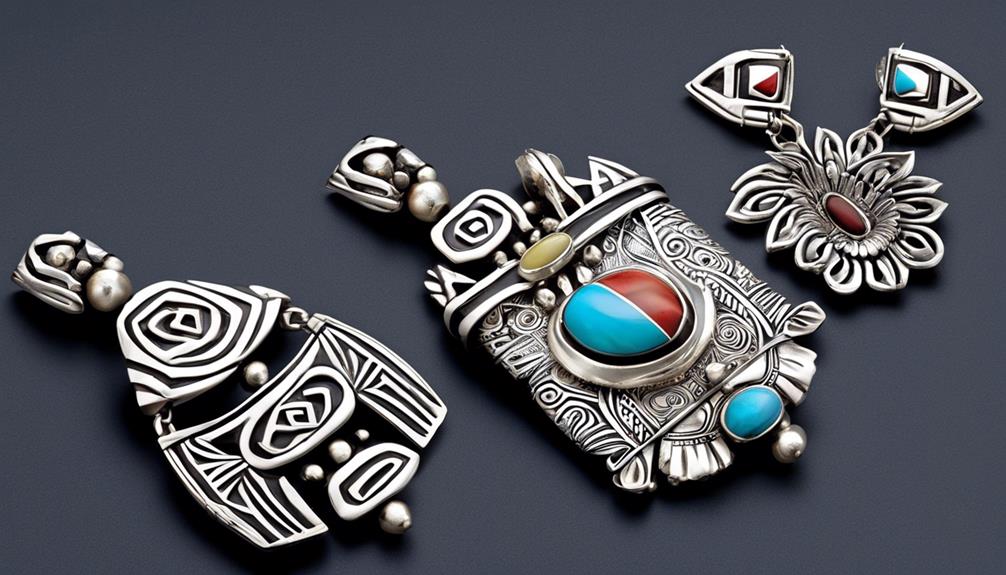
Adorning themselves with an array of meticulously crafted jewelry, the Hopi tribe intertwines cultural symbolism with artistic expression, reflecting their deep spiritual connection to the natural world. The jewelry of the Hopi tribe is a breathtaking display of their skilled craftsmanship and profound cultural heritage.
Here are some key aspects of the jewelry crafted by the Hopi tribe:
- Silver Earrings and Turquoise Necklaces: The Hopi tribe is renowned for their exquisite silver earrings and intricate turquoise necklaces. These pieces often feature intricate designs inspired by nature and the spiritual beliefs of the tribe.
- Beadwork Techniques: The Hopi tribe employs beadwork techniques that have been passed down through generations. These techniques result in stunning, colorful beadwork that adorns various pieces of jewelry, adding vibrant detail to their designs.
- Traditional Designs: The jewelry of the Hopi tribe often incorporates traditional designs that hold deep cultural significance. These designs aren't only aesthetically beautiful but also convey the stories and beliefs of the tribe, making each piece a profound symbol of their heritage.
The jewelry of the Hopi tribe serves as a testament to their rich cultural traditions and artistic expertise, offering a captivating glimpse into their world of beauty and spirituality.
Basketry
Woven with meticulous skill and deep cultural significance, the basketry of the Hopi tribe encapsulates their profound connection to nature and their artistic mastery. The intricate patterns and symbols woven into each basket reflect the tribe's rich cultural heritage, with designs often representing elements of the natural world and spiritual beliefs. The techniques used in Hopi basket making are passed down through generations, and the craft holds a central place in the tribe's traditions, serving as a way to preserve and transmit their cultural knowledge.
Hopi basketry has transcended its traditional roots and found modern applications, with contemporary artists incorporating innovative designs while still honoring the ancient techniques. While the art form has evolved, the tribe continues to prioritize sustainable practices, using locally sourced materials and natural dyes to minimize environmental impact. The baskets themselves serve both utilitarian and artistic purposes, with some being used for storage and others crafted as decorative pieces highly sought after by collectors and art enthusiasts.
The enduring cultural significance, meticulous techniques, and evolving modern applications of Hopi basketry make it a testament to the tribe's enduring artistic legacy and deep connection to their ancestral traditions.
Frequently Asked Questions
What Are the Traditional Methods and Techniques Used by the Hopi Tribe to Make Their Pottery?
Traditional techniques employed by the Hopi tribe for pottery design are rooted in their cultural significance.
Hopi tribe ceramics are created using coil and scrape methods, with clay gathered from specific locations.
The intricate designs showcase the tribe's spiritual beliefs and natural surroundings.
Comparatively, Hopi pottery stands out for its unique use of slip and firing techniques, distinguishing it from other Native American pottery traditions.
How Do the Hopi Tribe Use Kachina Dolls in Their Religious and Cultural Ceremonies?
In our cultural and religious ceremonies, the Hopi tribe uses Kachina dolls with deep spiritual significance. These unique dolls are integral to our cultural practices, representing various deities and ancestral spirits.
While our pottery techniques, textile production, jewelry materials, and basket types hold their own significance, the ceremonial uses of Kachina dolls are deeply rooted in our traditions and are a crucial part of our religious and cultural heritage.
What Types of Textiles Are Typically Made by the Hopi Tribe, and What Are They Used For?
Textile designs are an integral part of Hopi culture, with weaving techniques passed down through generations. These textiles hold immense cultural significance, often depicting symbolic motifs and designs that carry deep meaning. Traditionally, they were used for clothing, ceremonial regalia, and as trade items.
Today, these textiles are also incorporated into modern applications, such as contemporary artwork and crafts, preserving and honoring the rich tradition of Hopi weaving.
What Materials and Symbols Are Commonly Used in the Jewelry Made by the Hopi Tribe?
Materials commonly used in Hopi jewelry making include silver, turquoise, and coral. The techniques employed are intricate and often involve overlay and inlay work.
Symbols such as the sun, water, and migration are prevalent, each holding deep cultural significance.
Hopi jewelry is renowned for its unique craftsmanship and storytelling elements, reflecting the tribe's rich heritage.
Can You Describe the Different Types of Baskets Made by the Hopi Tribe and Their Uses in Daily Life and Ceremonies?
Hopi baskets play a crucial role in daily life and ceremonies. Crafted using traditional methods, these baskets showcase the Hopi tribe's mastery in pottery techniques. They come in various types, each serving a distinct purpose. Some are used for storage, others for ceremonial offerings.
The intricate designs and symbolism woven into these baskets reflect the tribe's deep cultural and spiritual connections. The artistry and functionality of Hopi baskets are a testament to their rich heritage.
Conclusion
In conclusion, the Hopi tribe created a variety of exquisite crafts. They ranged from intricate pottery and colorful kachina dolls to beautiful textiles, jewelry, and basketry. Their skilled craftsmanship and attention to detail are evident in each piece. This showcases the rich cultural heritage and artistic traditions of the Hopi people. These stunning creations are a testament to the creativity and ingenuity of the tribe. They continue to be cherished and admired by many.
Mary is a passionate writer who brings creativity and a fresh perspective to our team. Her words have the power to captivate and inspire, making her an essential contributor to our content. Mary’s commitment to storytelling and dedication to promoting Indigenous culture ensures that her work touches the hearts of our readers. We’re fortunate to have her as part of our team.
